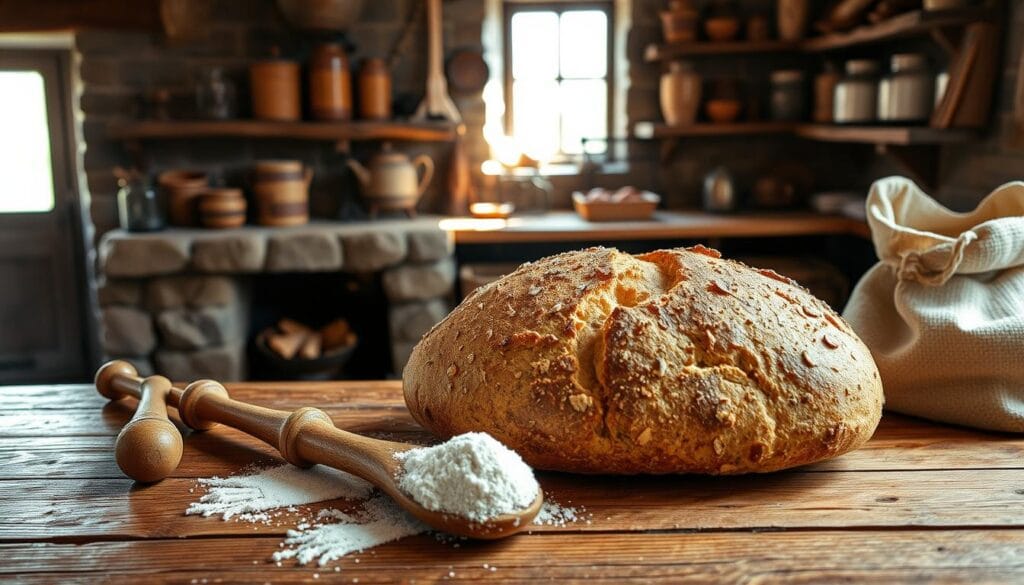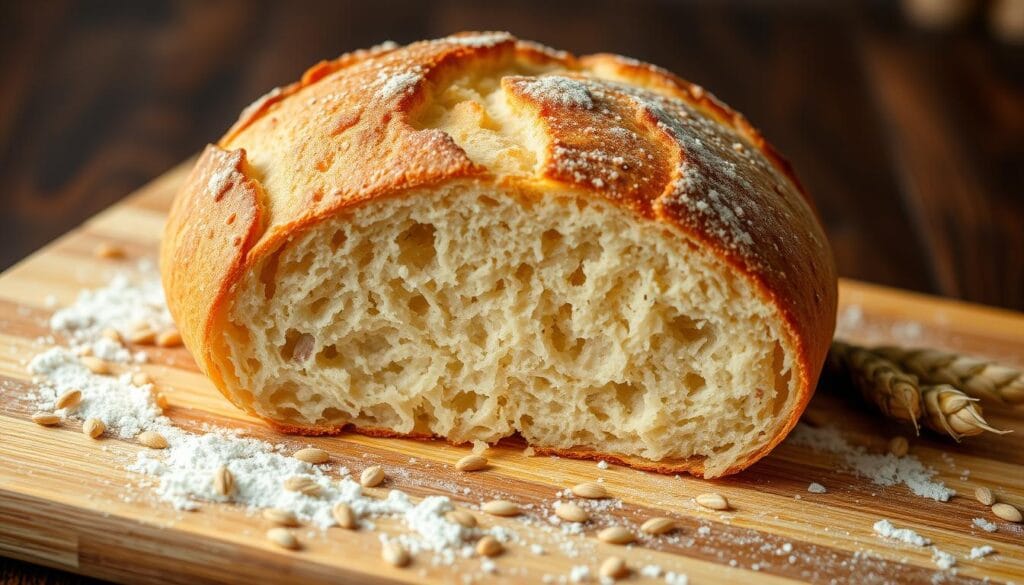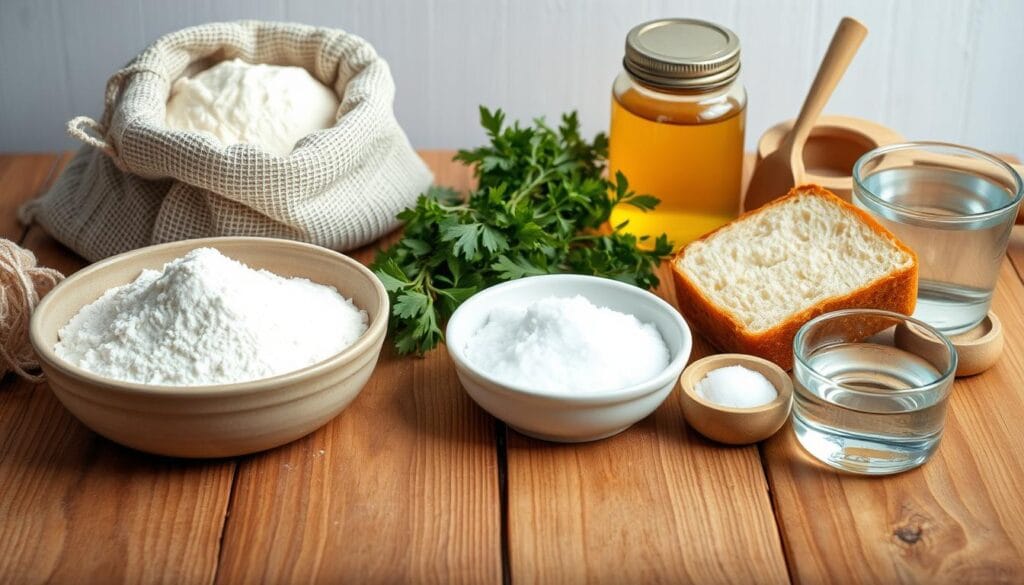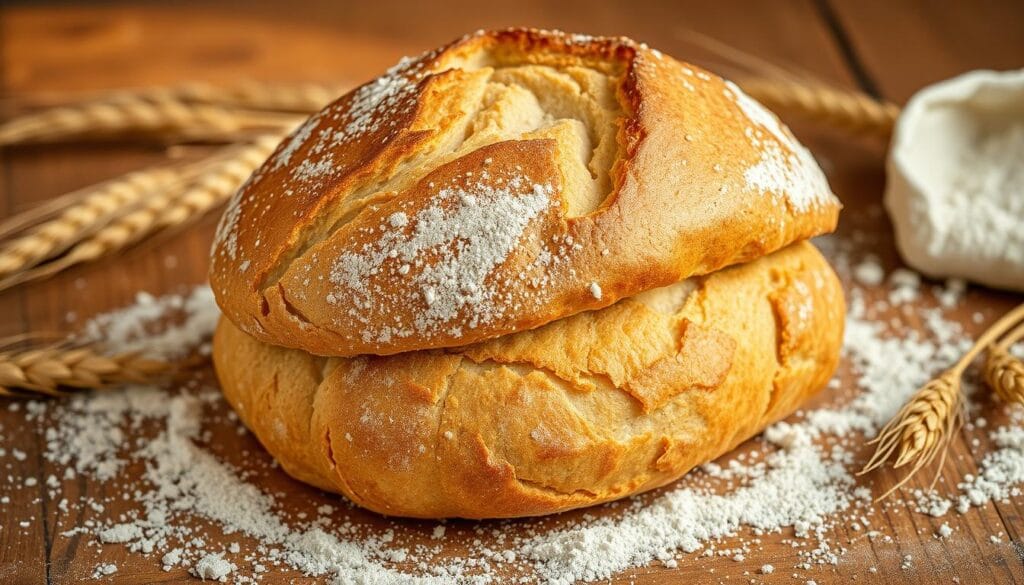I love baking cottage bread because of its rustic charm. This British loaf has a unique two-tier look. It’s not just pretty; it’s also delicious and hearty.
Whether you’re new to baking or experienced, making cottage bread is rewarding. It opens up new culinary adventures.
In this guide, we’ll dive into cottage bread’s history and special features. We’ll cover the key ingredients, how to shape it, and baking tips. You’ll learn to make your own amazing cottage bread.
History and Origins of Cottage Bread
Cottage bread started in the early 1800s. It was baked in traditional brick ovens. This method gave it a special crust and texture.
As it evolved, it became a favorite in many homes. Its two-tier structure was practical for small ovens.
Early 19th Century Emergence
In the early 1800s, cottage bread became popular. It was a rustic, homemade choice. The growing middle class loved its honest, artisanal taste.
It was baked in small, wood-fired brick ovens. This gave it a unique flavor and crisp crust.
Traditional Brick Oven Baking Methods
Brick ovens were key to cottage bread’s special qualities. They provided even heat and kept moisture in. This made the bread soft inside and crispy outside.
The baking techniques used in these ovens were part of the tradition.
Evolution Through British Baking History
Cottage bread evolved with British baking trends. Its two-tier structure became a hallmark. The lower tier was sturdy, and the upper tier added beauty and texture.
This design was both pretty and practical. It worked well in small ovens of the time.
Today, it is a beloved part of British baking. Its rustic charm and flavor still win the hearts of bakers and bread lovers.

What Makes Cottage Bread Different
It is a special kind of bread that people love. It has a unique two-tier shape, with a big base and a small top. This shape makes it look rustic and pretty, and it changes how the bread is baked.
The bread has a crispy, golden crust and a soft inside. It tastes rich and a bit sweet. The way it’s shaped and baked makes it taste and feel special.
- Unique Two-Tier Structure: The bread’s distinctive shape, with a larger base and smaller top, is a hallmark of cottage bread.
- Crisp Exterior, Soft Interior: Cottage bread boasts a crisp, golden crust that gives way to a soft, chewy crumb within.
- Rich, Slightly Sweet Flavor: The bread’s flavor profile is often described as rich and slightly sweet, with a depth of complexity.
- Shaping and Baking Techniques: The specific shaping and baking methods used for cottage bread are essential in achieving its characteristic appearance and taste.
These special features make it different from other breads. It’s a favorite among bakers and bread lovers.

Essential Ingredients for Authentic Cottage Bread
Every delicious cottage bread loaf starts with special ingredients. High-quality bread flour gives it structure and texture. Active dry yeast makes it rise.
Core Components and Their Roles
The main ingredients for are:
- Bread Flour: This flour is high in protein. It makes the bread strong yet light.
- Active Dry Yeast: This yeast is common. It makes the bread rise well.
- Salt: A little salt adds flavor. It also helps the yeast work right.
- Sugar: Sugar feeds the yeast. It helps the bread rise well.
- Water: The right water amount makes the dough just right.
Quality of Flour Selection
Choosing the right flour is key for cottage bread. Bread flour is best because it has more protein. This makes the bread chewy and strong.
Importance of Proper Yeast Types
The yeast you use matters a lot. Active dry yeast is popular because it makes the bread rise well. Trying different yeasts can change the bread’s taste.

The Unique Two-Tier Structure
The cottage loaf bread is known for its two-tier shape. It has a big base loaf and a smaller one on top. This shape makes the bread look special and changes how it bakes and feels.
To make this special shape, bakers use special ways to shape the dough. They build tension in the dough to hold the two tiers together. They also join the tiers carefully. Learning these steps is key to making real cottage loaf bread.
- The two-tier structure is a defining characteristic of cottage loaf bread
- The unique shape affects the baking process and final texture of the bread
- The two tiers create varying levels of crust, contributing to complex flavors
- Specific shaping techniques are necessary to build the two-tier structure
- Careful dough handling is crucial for successfully joining the two tiers

The two-tier shape of cottage loaf bread shows the talent of traditional bakers. By learning special techniques, bakers make a bread that looks amazing and tastes great.
Mastering the Cottage Bread Shaping Technique
Making perfect cottage bread needs skill and technique. Shaping the dough is key. It can make or break the bread. Learning how to shape cottage bread can help you get the right look and feel.
Building Proper Dough Tension
Getting the dough tension right is important. It helps the bread stand up. You need to handle the dough gently to get it just right.
This way, the dough becomes strong and ready for the bread’s two-tier design. With a little practice, you’ll get good at making the dough tight and even. This is the start of making a beautiful cottage loaf.
Joining the Two Tiers Successfully
Cottage bread is known for its two tiers. You need to shape and join two dough balls carefully. This is tricky but important for the bread’s look and feel.
Common Shaping Mistakes to Avoid
- Insufficient Dough Tension: Not enough tension can make the loaf fall apart or look bad.
- Improper Joining of the Tiers: If the dough balls don’t join well, the bread might not bake evenly.
- Uneven Sizing of the Tiers: If the dough balls are not the same size, the bread won’t look right.
Learning to shape it well is a big achievement. It takes patience and attention to detail. With practice, you’ll get better at making beautiful cottage bread.
Perfect Proofing Methods for Cottage Bread
Proofing is key to making tasty cottage bread. The dough needs two rises: a first bulk fermentation and a second after shaping. The first rise should make the dough double in size, taking about 45 minutes to an hour.
The second proof lasts 30 to 45 minutes after shaping. It’s vital for the bread’s great taste and texture.
Watch the dough closely to make sure it’s ready for the oven. It’s done when it springs back a bit when pressed. This means it’s ready to bake into a beautiful, doubled in size loaf.
Getting good at proofing takes time, but it’s worth it. By following these tips, you’ll make it with a light crumb and crisp crust. Be gentle with the dough when shaping to keep it soft and ensure a good second rise.
| Proofing Stage | Time Required | Dough Behavior |
|---|---|---|
| Initial Bulk Fermentation | 45 minutes to 1 hour | Dough should double in size |
| Second Rise After Shaping | 30 to 45 minutes | Dough should spring back slowly when lightly pressed |
Achieving the Signature Cottage Bread Crust
The hallmark of exceptional bread is its golden, crisp crust. This crust is soft and pillowy inside. To get this crust, bakers use special baking techniques like steam and precise temperature control.
Steam Baking Techniques
Steam is key in the early baking phase. This method, called “steam baking,” makes the crust shiny and crackly. Bakers use pans of hot water or spray the dough with water to get this effect.
Temperature Control Tips
Temperature control is also crucial for the perfect crust. Most recipes bake at 375°F (190°C) for 35-40 minutes. The bread is done when it sounds hollow when tapped.
By mastering steam baking and temperature control, bakers get the signature bread crust of cottage bread. This focus on detail and traditional techniques makes cottage bread special.
Troubleshooting Common Cottage Bread Challenges
Baking the perfect cottage bread can be tricky. But, with the right tips, you can overcome these issues. This way, you’ll get the classic, well-structured loaf you want. Let’s look at some common problems and how to fix them for your baking success.
Uneven Rising
If your it doesn’t rise evenly, it might be because of badproofing. Make sure the dough proofs for the right time in a warm, still place. Also, check that your yeast is fresh and active for even rising.
Separation of the Two Tiers
The two-tier structure of it is a key feature. If the tiers split during baking, it could be due to bad shaping. Work on building strong dough and sealing the tiers well before baking.
Dense, Heavy Texture
A dense, heavy texture can come from not enough gluten or over-kneading. Knead the dough until it’s smooth and elastic, but don’t overdo it. Also, let the dough rest and ferment well for a light, airy crumb.
Tough, Overbaked Crust
An overly tough, dark crust means it was baked too hot or for too long. Watch your baking time and temperature closely. Using a baking stone or steel can help get a perfect, golden crust.
By tackling these bread-baking challenges, bread troubleshooting, and using the best baking tips, you’ll make amazing, artisanal cottage bread at home.
Storage and Serving Suggestions
Keeping your cottage bread fresh is key. Let it cool on a wire rack first. Then, store it in a paper bag or bread box at room temperature for 2-3 days. For longer storage, freeze it for up to 3 months.
Serving it slightly warm is best. It’s great with creamy butter, artisanal cheeses, or as a side to soups and stews. Its texture is also perfect for toast or sandwiches, letting you enjoy its flavor in many ways.
Proper Storage Methods
- Store at room temperature in a paper bag or bread box for 2-3 days
- Freeze for up to 3 months for longer-term storage
Best Serving Practices
- Serve the bread slightly warm for optimal enjoyment
- Pair with butter, cheese, or as a side for soups and stews
- Use for toast or sandwiches to showcase the bread’s unique texture and flavor
| Storage Method | Duration |
|---|---|
| Room temperature (paper bag or bread box) | 2-3 days |
| Frozen | Up to 3 months |
Follow these tips to enjoy your homemade cottage bread for days. It’s a treat you can look forward to.
Modern Adaptations of Traditional Cottage Bread
Modern bakers have made cottage bread their own. They use whole grains, seeds, or different flours. This makes the bread healthier and tastier. Sourdough versions add a tangy flavor and keep the bread fresh longer.
Bakers also add special ingredients like herbs, cheeses, or dried fruits. These add-ins make it even more delicious. But, the bread’s two-tier shape is always the same. It’s what makes it special compared to other artisan bread.
Whether you like the old-fashioned cottage bread or the new versions, it’s loved by all. Its lasting charm and ability to change with the times make it a favorite. It is a key player in the world of modern bread recipes.
| Traditional Cottage Bread | Modern Cottage Bread Adaptations |
|---|---|
|
|
Comparing Cottage Bread to Other Artisan Loaves
It looks rustic and is baked the old way. It’s different because of its two-tier shape. It tastes milder and has a softer crust than sourdough, perfect for beginners.
It’s not like plain white bread. It tastes richer and feels more substantial. It’s great for sandwiches, soups, and stews because of its texture.
| Bread Characteristic | Cottage Bread | Sourdough | Sandwich Bread |
|---|---|---|---|
| Flavor | Mild | Tangy | Plain |
| Crust | Soft | Crisp | Soft |
| Crumb Texture | Robust | Chewy | Soft |
| Baking Method | Traditional | Artisanal | Commercial |
It is special among artisan bread types. It offers a mix of tradition, taste, and flexibility for bakers.
Conclusion
It is special in the world of baking. It has a unique two-tier structure, rich flavor, and is very versatile.
Its special ingredients, shaping, and baking make it stand out. It comes from British baking traditions but has modern twists too. To make great cottage bread, you must know its history, its ingredients, and how to bake it.
It is becoming more popular. It’s easy to make and good for you. It has lots of protein, is low in carbs, and tastes creamy.
It is a favorite among artisan bread lovers and is great for low-carb or gluten-free diets. You can also enjoy it for its taste.
In short, it is unique. Its two-tier structure and strong flavor make it special. By learning about its history, ingredients, and baking, you can make perfect cottage bread at home.
FAQ
What is cottage bread?
It is a traditional British loaf. It has a two-tier structure. This makes it look rustic and feel hearty.
What are the key characteristics of cottage bread?
It stands out because of its two-tier shape. It has a big base and a small top. This shape makes it look rustic and changes how it bakes and feels.
What are the essential ingredients in cottage bread?
It needs good bread flour, yeast, salt, sugar, and water. In some recipes add butter or oil for extra flavor.
What are the steps in shaping cottage bread?
Shaping it takes skill. You make two dough balls and join them. This keeps the two-tier shape during proofing and baking.
How is the signature cottage bread crust achieved?
The crust is made by special baking methods. Steam baking makes it crisp and golden. Keeping the right temperature is also key.
What are some common challenges in baking cottage bread?
Bakers often face uneven rising and a dense texture. These problems can be fixed by adjusting proofing times and improving shaping. Changing ingredient ratios can also help.
How should cottage bread be stored and served?
Store It in a paper bag or bread box at room temperature. It stays fresh for 2-3 days. For longer storage, freeze it for up to 3 months. Serve it warm with butter, and cheese, or as a side for soups and stews.
How does cottage bread differ from other artisan loaves?
It looks rustic like other artisan loaves but has a unique two-tier shape. It tastes milder than sourdough and has a softer crust. It’s shaped differently and tastes richer than plain white bread.

